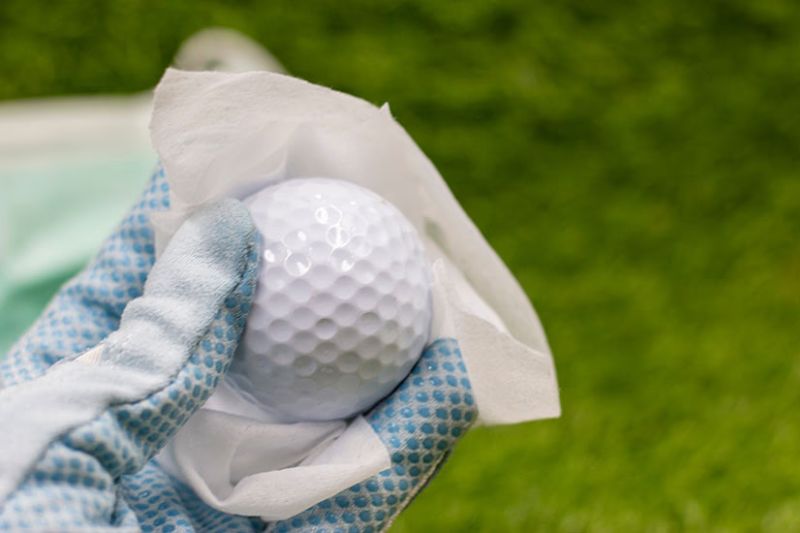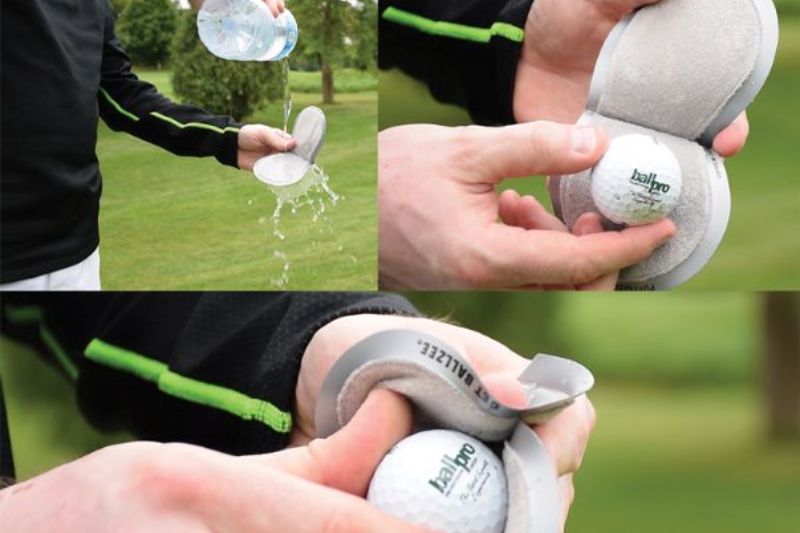Golf is a beloved sport that captivates millions around the world. Whether you’re playing on pristine championship courses or winding local layouts, every golfer can relate to the frustration of hitting a dirty ball. Not only does a grimy golf ball detract from your enjoyment of the game, but it can also negatively impact your performance. That’s why this comprehensive guide focuses on how to clean dirty golf balls effectively and efficiently. In the following sections, we will dive deep into the essential tools and techniques for golf ball cleaning, as well as explore advanced methods for stubborn stains.
How to Clean Dirty Golf Balls: A Comprehensive Guide

Cleaning your golf balls should be an integral part of your routine, whether you’re a beginner or an experienced player. A clean ball not only looks better, but it also performs better. Over time, dirt can collect on the surface of a golf ball, disrupting its aerodynamics and affecting the way it travels through the air.
Understanding the importance of cleaning your golf balls goes beyond aesthetics. Factors such as aerodynamics and spin play a crucial role in your game. A clean ball can help you achieve better control and accuracy, leading to improved scores.
In this section, we’ll delve deeper into the significant impacts of unclean balls versus cleaned ones. We’ll also discuss how often you should clean your golf balls and the benefits of staying on top of this task.
The Impact of Dirt on Performance
When a golf ball comes into contact with various surfaces—such as grass, mud, sand, or water—it collects dirt and debris. This buildup can lead to unpredictable results when striking the ball. For instance, a ball covered with mud may not roll straight or could have reduced distance. As a player, you want every shot to reflect your skill level, which is why keeping your equipment in good condition is essential.
A clean ball has smoother airflow over its surface, allowing for a more stable trajectory. In contrast, a dirty ball can create turbulence, causing erratic flight paths and potential inaccuracies.
Frequency of Cleaning
The frequency with which you clean your golf balls can depend on several factors, including the type of course you play and the weather conditions. If you’re playing in muddy or wet conditions, it’s advisable to clean your balls after every round. For drier climates, a quick wipe down after each hole might suffice. Regular maintenance ensures a consistent gaming experience, allowing you to focus on your swing rather than worrying about your equipment’s condition.
Beyond Just Aesthetics
While it’s nice to have shiny, clean golf balls, the real advantage lies in improved performance. When you make the effort to clean your balls regularly, you’ll notice a marked improvement in consistency during your rounds. A clean ball gives you more confidence in your shots, allowing you to focus on your technique.
Essential Tools and Techniques for Golf Ball Cleaning

Before you embark on your journey toward cleaner golf balls, it’s essential to gather the right tools and understand the techniques required for effective cleaning.
Essential Tools for Cleaning Golf Balls
The first step in cleaning your golf balls is to assemble the necessary tools. Having the right equipment can make the process easier and more efficient. Here are some tools you should consider:
Soft-bristled Brush: A soft-bristled brush designed specifically for cleaning golf balls is perfect for gently removing dirt without damaging the surface. These brushes are typically crafted with materials that won’t scratch the ball, ensuring it retains its integrity.
Old Toothbrush: Don’t throw away that old toothbrush just yet! Its bristles are great for getting into the nooks and crannies of textured golf balls. An old toothbrush can work wonders for those hard-to-reach spots.
Microfiber Cloth: A microfiber cloth is essential for drying and polishing your golf balls. Its lint-free nature means that it won’t leave any residue behind, providing a clean finish.
Bucket or Bowl: Use a container to hold your cleaning solution. It can be as simple as a bucket filled with warm soapy water or a specialized golf ball cleaning solution.
Choosing the Right Cleaning Solution
Selecting the appropriate cleaning solution is another vital aspect of maintaining your golf balls. Depending on how dirty your golf balls are, you can choose between different solutions.
Simple Approach: For light dirt accumulated during a round of golf, warm water mixed with a few drops of dish soap can do the trick. This simple mixture helps loosen dirt without causing damage.
Advanced Cleaning: If your golf balls have stubborn dirt, grease, or stains, consider using a specialized golf ball cleaning solution. Many manufacturers offer products made specifically for this purpose, and they can be very effective.
Cleaning Techniques for Golf Balls
Once you have your tools ready, it’s time to put them to use. Understanding the proper cleaning techniques will allow you to get your golf balls back to their optimal condition quickly.
Gentle Approach: While it may be tempting to scrub hard to remove dirt, this can damage the outer layers of a golf ball. Instead, use gentle strokes to avoid scratching the surface while effectively removing debris.
Cleaning Order: Start your cleaning process with the soft-bristled brush to remove loose dirt and debris. Follow this up with the old toothbrush to tackle harder-to-reach areas where dirt tends to accumulate.
Drying Thoroughly: After cleaning, always ensure that your balls are completely dry before storing them. Moisture can lead to mold or mildew, compromising the quality of your equipment.
How Cleaning Improves Your Performance
A clean golf ball offers significant performance advantages that can elevate your game. Understanding these benefits underscores the importance of regular cleaning.
Aerodynamics Matter
Aerodynamics plays a pivotal role in how a golf ball performs in flight. A clean golf ball allows for smooth airflow, which is critical for stability and distance. When dirt accumulates, it disrupts this airflow, leading to erratic trajectories that can negatively impact your game.
Spin and Control
The ability to control spin is essential for executing various shots, especially around the greens. Dirt and grime can alter a ball’s spin rate, making it challenging to predict how the ball will react upon landing. By maintaining clean balls, you enhance your control over spin, enabling you to land shots closer to your target.
Improved Visibility
Visibility is another essential factor in golf. A clean ball stands out against the green grass, helping players track its flight more easily. This improved visibility can lead to better club selection and sharper focus, ultimately contributing to lower scores.
Durability and Lifespan
Lastly, dirt and debris can embed themselves into the ball’s surface, causing scratches and blemishes. Regular cleaning helps maintain the ball’s structural integrity, prolonging its lifespan and saving you money in the long run.
A Practical Guide to Removing Dirt and Debris
The process of cleaning your golf balls doesn’t have to be complicated. Here’s a straightforward step-by-step guide to help you remove dirt and debris effectively.
Gather Your Gear
Start by ensuring you have all the necessary tools and cleaning solutions readily available. This preparation will streamline the cleaning process, allowing you to focus on each step without interruptions.
Prepare the Cleaning Solution
Depending on the level of dirt on your golf balls, prepare your cleaning solution accordingly.
Simple Approach: For light dirt, fill a bucket with warm water and add a few drops of dish soap. This basic solution is often enough to handle most cleaning jobs.
Advanced Cleaning: If you’re dealing with stubborn stains or heavy grime, consider using a specialized golf ball cleaning solution as directed by the manufacturer.
Scrub the Ball
Once you’ve prepared your cleaning solution, it’s time to scrub the golf ball.
Soft-bristled Brush: Use the soft-bristled brush to gently scrub the ball, paying particular attention to areas with heavy dirt accumulation. The goal here is to remove as much dirt as possible without damaging the surface.
Old Toothbrush: Switch to the old toothbrush to focus on crevices and grooves, where dirt tends to gather. Make sure to be thorough but gentle during this step.
Rinse and Dry
After scrubbing, rinse the golf ball thoroughly under running water to remove all traces of the cleaning solution and dirt. Then, allow the ball to air dry completely before storing it. Proper drying prevents mold and mildew from forming, ultimately preserving the integrity of your equipment.
Cleaning Techniques for Different Types of Soiling

Not all dirt is created equal, and different types of soiling require unique cleaning methods. Knowing how to tackle various types of mess will keep your golf balls in excellent condition.
Dealing with Muddy Balls
Muddy balls can be particularly troublesome, especially if you’ve played in wet conditions.
Initial Removal: Begin by scraping off any loose mud with a brush or even your fingers. This step allows the cleaning solution to work more effectively.
Soaking: Soak the ball in a bucket of warm water mixed with dish soap for a few minutes. This soaking will help loosen any remaining mud that may be clinging to the ball’s surface.
Scrubbing: After soaking, use a soft-bristled brush to gently scrub away the remaining mud. Pay extra attention to the dimples, as they can trap dirt.
Rinse and Dry: Rinse thoroughly and let the ball dry completely before putting it away.
Tackling Grass Stains
Grass stains can be somewhat difficult to remove but can usually be treated effectively.
Soaking: Like muddy balls, soak the stained ball in a solution of warm water and dish soap for a few minutes. This soaking helps break down grass stains.
Scrubbing: After soaking, use a soft-bristled brush to gently scrub the ball, focusing on the stained areas. This method usually removes most grass stains effectively.
Polishing: Finish by polishing the ball with a microfiber cloth for a shiny finish.
Handling Markings and Scuffs
Light scuffs and markings can mar an otherwise clean golf ball, but there are effective ways to address them.
Magic Eraser: A magic eraser can help remove light scuffs and markings. Simply rub the affected area gently until the marks disappear.
Paint Remover: For stubborn markings, a mild paint remover can be used, but it’s essential to test it on an inconspicuous area first. Too harsh of a solution can damage the ball’s surface.
Beyond the Basics: Advanced Cleaning Methods for Stubborn Stains
Sometimes, standard cleaning methods just won’t cut it. For those particularly stubborn stains, consider employing these more advanced techniques.
Vinegar Soak
Vinegar is a natural cleaning agent that works wonders on tough stains.
Solution: Create a solution of equal parts white vinegar and water.
Soaking: Soak the ball in this solution for one to two hours. The acidity of the vinegar helps break down stubborn grime.
Scrubbing: After soaking, gently scrub the ball with a brush to remove any lingering stains.
Rinse and Dry: Rinse thoroughly and dry completely, ensuring no vinegar remains on the ball.
Baking Soda Scrub
Baking soda is another excellent household product for stubborn stains.
Paste: Create a paste by mixing baking soda with water. The pasty consistency acts as a gentle abrasive.
Scrubbing: Apply the paste directly to the stain and scrub gently with a soft-bristled brush. The combination of baking soda and water works effectively to lift dirt and stains.
Rinse and Dry: Rinse off the paste and let the ball dry completely.
Commercial Cleaners
If you prefer convenience, numerous specialized golf ball cleaners are available on the market.
Specialized Solutions: Research and find a reputable brand that offers solutions specifically designed for golf balls.
Follow Instructions: Always read and follow the instructions provided on the packaging to ensure effective cleaning without damaging your balls.
Maintaining Your Shine: Tips for Keeping Your Golf Balls Clean
Once you’ve successfully cleaned your golf balls, it’s essential to maintain their cleanliness. Here are some practical tips to keep them shining throughout your golfing journey.
Clean After Each Round
Make it a habit to wipe down your golf balls after each round. A quick rinse or wipe can go a long way in preventing dirt buildup.
Quick Rinse for Heavy Dirt
If your golf balls are particularly dirty, consider giving them a quick rinse immediately after your round. This action will prevent dried-on mud or grass from setting in.
Stick to a Schedule
In addition to cleaning after each round, establish a more thorough cleaning routine. Aim to clean your golf balls weekly to keep them in tip-top shape.
Store Properly
How you store your golf balls can also affect their cleanliness. Keep them in a clean, dry environment to minimize dust accumulation. Consider using a dedicated golf ball bag to protect them from dirt and moisture.
The Science of Clean: Understanding the Impacts of Dirt on Ball Performance
Understanding the science behind a clean golf ball can significantly influence how you approach your game. The relationship between cleanliness and performance is governed by principles of physics.
Aerodynamics Explained
Aerodynamics is the study of how air interacts with solid objects—in this case, your golf ball. When a ball is dirty, it creates friction that disrupts the smooth flow of air over its surface.
This disruption leads to inconsistent performance characteristics, which can manifest as unpredictable flight patterns and distances. Conversely, a clean ball maintains a streamlined profile, enhancing distance and accuracy.
The Role of Spin
An important aspect of spinning the ball, particularly on approach shots, is how clean the ball is. Dirt interrupts the transfer of energy during impact, affecting spin rate and control. A clean ball facilitates more effective energy transfer, resulting in optimal spin rates, precise movement, and improved accuracy on the course.
Visibility and Focus
Finally, the visibility of a clean golf ball aids in overall focus and concentration. As mentioned earlier, a clean ball contrasts better against green grass, helping players track its flight path. Enhanced visibility leads to better decision-making concerning club selection and shot execution.
Cleaning on a Budget: Affordable Solutions for a Sparkling Ball
Cleaning your golf balls doesn’t have to be expensive. In fact, there are many budget-friendly solutions that are both effective and easy to implement.
Dish Soap
A simple solution of warm water and dish soap can effectively clean most golf balls. This inexpensive method allows you to maintain your equipment without breaking the bank.
Baking Soda
Baking soda is a natural cleaning agent that can remove dirt and stains. Use it in conjunction with water to create a paste, or simply sprinkle it directly onto stains before scrubbing.
Vinegar
White vinegar is another affordable option that works wonders for tough stains. It’s readily available in most households and can be utilized in various cleaning applications.
Magic Eraser
Magic erasers are inexpensive cleaning tools that can help remove light scuffs and markings from your golf balls. Their versatility makes them a valuable addition to your cleaning arsenal.
DIY Solutions
Consider creating your own cleaning solutions using common household ingredients like lemon juice, dish soap, or baking soda. These DIY options are cost-effective and often yield impressive results.
Eco-Friendly Cleaning: Sustainable Practices for Your Golf Balls
As awareness of environmental issues grows, many golfers seek eco-friendly cleaning practices. Implementing sustainable methods benefits the planet and promotes responsible golf practices.
Choose Biodegradable Products
Look for cleaning solutions that contain natural and biodegradable ingredients. These products break down more easily in the environment and reduce chemical pollution.
Avoid Harsh Chemicals
Steering clear of harsh chemicals is not only better for the environment but also safer for your health. Opt for gentler cleaning options whenever possible.
Reduce Water Usage
Minimize water usage by using a spray bottle instead of filling a bucket. Alternatively, rinse your golf balls in a small container to limit waste.
Reuse Cleaning Supplies
Instead of constantly purchasing new cleaning supplies, consider reusing old toothbrushes, cloths, and containers. This practice reduces waste and promotes sustainability.
Recycle Properly
Always recycle any cleaning supply packaging materials properly to minimize your environmental impact. Proper recycling helps reduce landfill waste and conserve resources.
Choosing eco-friendly cleaning methods not only benefits the environment but also sends a message of responsibility and respect for the game of golf.
Conclusion
Caring for your golf balls is a crucial aspect of maintaining your equipment and improving your game. Understanding how to clean dirty golf balls can elevate your performance while keeping your gear in great condition. From gathering the right tools to employing various cleaning methods, this comprehensive guide equips you with everything necessary to ensure your golf balls remain clean and effective.
By committing to regular cleaning and adopting sustainable practices, you can enjoy superior performance while also being mindful of your environmental impact. So next time you hit the course, remember the importance of a clean golf ball. Your scorecard will thank you!

I am the owner of Ricks Golf Shop, a popular destination for golf enthusiasts. My passion for golf began in my teenage years and has only grown over the years. With over 10 years of experience in the golf industry, I offer expert advice and quality products. With a friendly demeanor and extensive knowledge, I ensure every customer leaves happy.
